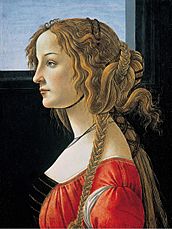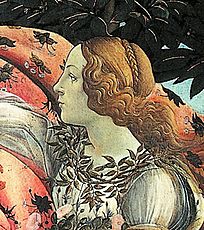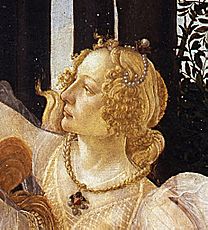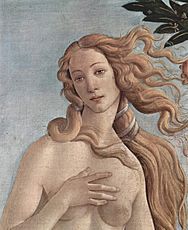Simonetta Vespucci facts for kids
Quick facts for kids
Simonetta Vespucci
|
|
|---|---|
| Born | 1453 Genoa or Portovenere, Republic of Genoa
|
| Died | 26 April 1476 (aged 22–23) Florence, Republic of Florence
|
| Spouse(s) |
Marco Vespucci
(m. 1469) |
| Parent(s) | Gaspare Cattaneo della Volta Caterina Violante Spinola (called Catocchia) |
Simonetta Vespucci (born Simonetta Cattaneo; 1453 – 26 April 1476) was a famous Italian noblewoman from Genoa. She was married to Marco Vespucci of Florence and was a cousin-in-law of the explorer Amerigo Vespucci. People called her la bella Simonetta, meaning "the beautiful Simonetta," because she was known as the most beautiful woman of her time in Italy.
Many paintings by famous Florentine artists like Sandro Botticelli and Piero di Cosimo are thought to show her. Some art experts, however, are not sure if all these paintings truly show Simonetta.
Contents
Life Story
Early Life and Marriage
Simonetta Cattaneo was born around 1453 in a part of the Republic of Genoa, which is now in the Liguria region of Italy. We don't know her exact birthplace, but it might have been the city of Genoa, or perhaps Portovenere or Fezzano. A poet named Politian wrote that she was born "among the waves," like the goddess Venus.
Her father was a nobleman named Gaspare Cattaneo della Volta. Her mother was Cattocchia Spinola.
When she was sixteen, Simonetta married Marco Vespucci. Marco was a distant cousin of the famous explorer Amerigo Vespucci. They met in April 1469 at a church in Genoa. Marco had been sent to Genoa by his father to study at a bank. Marco fell in love with Simonetta. Her parents agreed to the marriage because Marco's family was important in Florence and connected to the powerful Medici family.
Life in Florence
Simonetta and Marco got married in Florence in 1469. Simonetta quickly became very popular in the Florentine court. She caught the eye of the Medici brothers, Lorenzo and Giuliano. The Medici family even let the Vespucci wedding happen at their grand palace and held the reception at their beautiful Villa di Careggi.
In 1475, Giuliano de Medici took part in a jousting tournament called La Giostra. He carried a banner with a painting of Simonetta on it. She was shown as Pallas Athena, a goddess wearing a helmet. This painting was done by Botticelli. Below the image, it said La Sans Pareille in French, which means "The Unparalleled One" or "The One Without Equal." Giuliano won the tournament and named Simonetta "The Queen of Beauty" at the event.
Simonetta was clearly known for her amazing beauty in Florence. However, Giuliano's actions were part of a tradition called courtly love. This was a way for knights and nobles to show admiration for a lady, even if she was married. It's not known if Simonetta and Giuliano were ever truly in love, and it's unlikely they became a couple.
Her Death
Simonetta Vespucci died just one year later, on the night of April 26–27, 1476. She was only twenty-two years old. For a long time, people thought she died from tuberculosis. However, new ideas suggest she had a serious illness caused by a tumor.
After her death, her body was carried through the city in an open coffin so everyone could see her one last time. Her husband remarried soon after. Giuliano de Medici was killed in a plot against his family in 1478, exactly two years after Simonetta's death.
Simonetta in Art
The famous artist Sandro Botticelli painted many portraits of noblewomen. Several of these are believed to be paintings of Simonetta, but it's hard to be completely sure. Some experts think that even in his later works, Botticelli might have included her face. For example, he finished one of his most famous paintings, The Birth of Venus, around 1486, which was 10 years after Simonetta died. Some people believe the goddess Venus in this painting looks a lot like her.
Some art historians, like John Ruskin, thought that Botticelli was in love with Simonetta. They point to Botticelli's wish to be buried in the Church of Ognissanti in Florence, which was the Vespucci family's church. His wish came true when he died 34 years later in 1510. However, this church was also Botticelli's local church since he was a child, and his family was buried there.
Botticelli did paint the banner that Giuliano carried at the joust in 1475, which showed Simonetta as Pallas Athena. So, it seems he did paint her at least once, but that specific painting is now lost. Botticelli also painted Primavera as a wedding gift for Simonetta's niece, Semiramide, in 1482. Some people believe this painting also includes Simonetta's image.
Possible Depictions
-
Flora in The Birth of Venus by Sandro Botticelli, circa 1484-1486
-
One of the Three Graces in Primavera by Sandro Botticelli, circa 1482
-
The Venus figure, representing marriage, in Primavera by Sandro Botticelli, circa 1482
-
The Venus figure in The Birth of Venus by Sandro Botticelli, circa 1484-1486
About the two "Portrait of a Woman" paintings shown above, which are credited to Botticelli's workshop, art expert Ronald Lightbown says they were likely made by Botticelli's assistants, not just by Botticelli himself. He also notes that Botticelli's workshop created "fancy portraits of ideal beauties, rather than real ladies." This means these might be pictures of an "ideal" beautiful woman, not necessarily Simonetta herself.
Simonetta Vespucci might also be shown in a painting by Piero di Cosimo called Portrait of a woman, said to be of Simonetta Vespucci. This painting shows a woman as Cleopatra, with a snake around her neck. It's hard to know if this painting truly looks like Simonetta, especially because it was painted about 14 years after she died. Piero di Cosimo was only 14 years old when Simonetta passed away. The museum that has this painting, the Musée Condé, is not sure if it's really Simonetta. They note that her name might have been added to the bottom of the painting much later.
See also
 In Spanish: Simonetta Vespucci para niños
In Spanish: Simonetta Vespucci para niños







